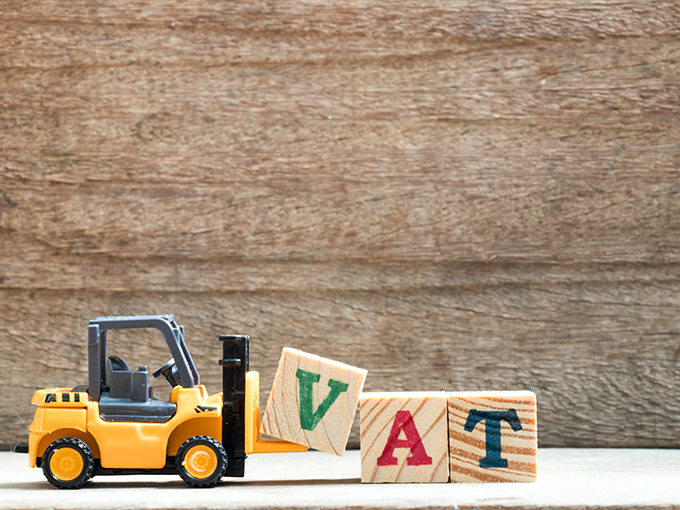In this month’s VAT Update, we examine the latest news and key cases, including:
- HMRC’s latest One to Many campaign to identify non-established taxable persons (NETP) incorporating in the UK,
- An update on the partial exemption case of Hippodrome Casino Limited,
- Why HMRC is paying repayment interest – and what this could mean for your business,
- The VAT implications of refer-a-friend schemes, and
- The outcome of a recent food VAT liability case with Walkers.
In our October 2023 VAT Update, we highlighted HMRC’s One to Many campaign to identify NETPs that are incorporating in the UK to avoid online marketplaces deducting VAT on sales made through their platforms. Current VAT rules require these platforms to account for VAT on sales made by non-resident businesses to UK consumers.
HMRC believes this approach is resulting in an unfair competitive disadvantage to genuine UK registered businesses who are registered for VAT and are paying it correctly.
A NETP is required to obtain VAT registration in the UK regardless of its taxable turnover levels –ie, the VAT registration threshold does not apply to NETPs. Under certain circumstances, a NETP who claims to be a UK registered business and sells below the VAT registration threshold could therefore not register for or collect VAT. As far as the online platforms are concerned, they are UK incorporated companies trading below the VAT registration threshold, so do not collect VAT on this basis.
To combat all these issues and to verify that its own records regarding the NETP population is correct, HMRC is writing to businesses that trade on online marketplaces, which it suspects are NETPs for UK VAT purposes. Businesses are required to respond with evidence of their UK establishment.
HMRC states that to be established in the UK for VAT purposes, the business must meet at least one of the following tests:
- It makes essential management decisions and carries out its main administration of the business in the UK – here it would have a business establishment in the UK, or
- It has a permanent physical presence in the UK, with human and technical resources capable of receiving or making taxable supplies – here it would be considered to have a fixed establishment in the UK.
For proof of the above, HMRC would accept rental and tenancy agreements, utility bills, council tax bills, and records of staff that the business employs, along with their National Insurance numbers.
HMRC has also clarified that mere incorporation in the UK is different from being established in the UK for VAT purposes.
Comments
Whether or not a company is established in the UK for VAT purposes impacts a number of areas of VAT in addition to the issue highlighted with HMRC’s One to Many campaign. The place of supply of services rules are based in large parts on where the supplier and the customer are established. Whether VAT is accountable in the UK on a supply being made, or a supply being received, is often determined by the place of establishment of both parties. A VAT registration or a UK incorporation alone do not create establishment. If there is no presence in the UK, the company’s registered address is that of a third party, and the company directors reside overseas, it’s likely there is no establishment in the UK and the company would be treated as an NETP for VAT purposes. This may create further issues for the company, particularly with respect to VAT recovery which may only be available through a specific VAT refund mechanism rather than through a standard VAT return.
Please get in touch Nick Hart, VAT Director, for further details.
Back in April 2022, we reported on the First Tier Tax Tribunal (FTT) decision in the case of Hippodrome Casino Limited. This case related to the method used to recover VAT on overhead costs. The Appellant felt the standard method of partial exemption based on income wasn’t fair and applied the standard method override (SMO) using a floor-based calculation. The FTT agreed this approach provided a fair and reasonable VAT recovery position.
HMRC appealed the decision and have now won at the Upper Tier Tax Tribunal (UTT) (UKUT 00027). The Hippodrome argued that the building on Leicester Square wasn’t just about VAT exempt gaming (the core part of the business) but about the experience. The building includes a theatre and restaurants as well as bars, all generating taxable income. However, the income from these activities was significantly less than that generated by the gaming. The Hippodrome was able to generate much greater revenues from a smaller space from gaming than it could from the same space in its restaurants and felt a floor area calculation was fairer. Under the standard income method, VAT recovery on overheads was 12-22%, though the floor area dictated 53% of taxable use for unallocated areas.
While the FTT accepted that a floor-space calculation did more accurately reflect the economic use of the expenditure than the standard method, the UTT found in favour for HMRC.
The UTT focused on the fact that a substantial, although not sole, purpose of providing hospitality and entertainment further encouraged gambling. The costs incurred in respect of the non-gambling areas still formed a significant cost component of the exempt gambling supplies. These areas provided facilities to the gambler and encouraged them to stay longer and spend; the UTT therefore found that the FTT had overlooked this dual use and must set aside the original decision. The UTT acknowledged that a floor-based calculation may still be more reliable that the standard method. However, where it’s used to displace the standard income method, it must be capable of fairly reflecting the use made of the premises for the different types of business in the ratios it produces.
Comments
This decision acts as a reminder regarding the SMO, which often gets overlooked by taxpayers using the partial exemption standard method. Notably it also highlights the fact that using an alternative to income (HMRC’s preference) must be more reliable than the standard method and accurately reflect use. While HMRC may not need to approve an override methodology, they are likely to challenge the approach take where they feel it’s not fair and doesn’t reflect the actual or intended use of the expenditure.
The SMO needs to be considered when residual input tax for a partial exemption year is at least £50,000. Adjustments under the SMO only become due where the difference in VAT recovery under the use-based SMO differs ‘significantly’ from the result produced by the standard method. ‘Significantly’ is a defined term in terms of the value of the difference.
Partial exemption remains a complex area of VAT and specialist advice is recommended when the SMO does need to be considered. Please get in touch with John Butterfield, VAT Director, for assistance.
As a VAT registered business, an understanding of the VAT repayment processes is important from a cash flow perspective. For those receiving regular VAT repayments, or those expecting a large repayment, it’s wise to ensure correct bank details are on file with HMRC. You may also receive more back than you were expecting! Keeping bank details updated
HMRC process VAT repayments directly into your bank account where it holds your business bank details on its system. Bank account changes should be communicated to HMRC in a timely manner through the online service tax account.
If you don’t provide HMRC with your business bank account details, it will only process VAT repayments via cheque by post, and there can be delays in this being received and deposited.
Overseas VAT registered companies due a VAT refund can provide HMRC with overseas bank details, and HMRC will process the refund directly into an overseas account. The overseas bank account must be in the company’s name and able to accept repayments in pounds sterling.
The necessary form must be submitted to HMRC, providing details of the overseas bank account before HMRC can transfer any VAT repayments. Again, if bank details aren’t provided, a cheque will be issued by post, which could take several weeks to arrive at the businesses overseas address.
If HMRC delays your VAT repayment, you may be entitled to repayment interest. For VAT accounting periods starting on or after 1 January 2023, repayment interest replaced the repayment supplement, and the system became a little more generous.
Repayment interest is calculated based on the Bank of England base rate minus 1%, with a minimum rate of 0.5%. HMRC pays repayment interest on the VAT amount owed to you (the taxpayer).
The repayment interest starts on the day after the later of these two dates:
- The submission deadline for the VAT return accounting period, or
- When the VAT return was actually submitted.
Since the inception of the repayment interest provisions, HMRC no longer has a time limit of 30 days to release the VAT refund.
For example, if the submission deadline for the return for quarter end 31 December 2023 is 7 February 2024, and the taxpayer submits the return to HMRC on 7 February 2024 showing an amount owed to them in the sum of £10,000, if HMRC doesn’t issue the repayment until 10 February 2024, then the taxpayer will be due repayment interest on the £10,000 for the three days from 8 to 10 February 2024 inclusive.
Repayment interest is added to the amount of VAT being refunded, so the amount received is sometimes higher than the amount anticipated.
Comments
Under the repayment interest provisions, VAT registered businesses are increasingly receiving repayment interest amounts in addition to their VAT repayments. This is particularly evident when the VAT return is submitted close to or on the return submission deadline. In such cases, the provisions only allow HMRC a single day for processing the repayment before repayment interest starts accruing to the taxpayer.
Letting HMRC know of any bank account changes is a simple step, but can result in unexpected delays with receiving VAT refunds if not promptly taken.
For further information on VAT repayments, please get in touch with your usual Saffery contact.
The recent case of Simple Energy Limited v HMRC [2023] TC08995 has highlighted potential issues when it comes to awarding non-monetary credits as part of refer-a-friend schemes.
Simple Energy Limited was the representative member of the VAT Group in which Bulb Energy Limited (Bulb) was a member. Bulb operated a refer-a-friend scheme where existing customers were provided with an electronic referral link, which they could pass on to friends and family in order for Bulb to gain new customers.
Where a new customer did sign up to Bulb, both the existing customer (the referrer) and new one received a credit of between £25 and £75 to offset against their energy charges. Multiple referrals could be made, meaning the referrer could receive multiple credits. Bulb treated the referrals as performance of a contingency, which resulted in a discount from the value of the energy supply Bulb made to the referrer.
Bulb accounted for output VAT based on the payments it had received from its customers, net of the refer-a-friend credits. HMRC disagreed with this treatment, arguing that the refer-a-friend scheme was the provision of a service by the referrer to Bulb. HMRC also argued that the service was a non-monetary consideration, meaning that output VAT should have been accounted for on Bulb’s charges before the refer-a-friend scheme was applied to each customer’s account. HMRC issued a decision to this effect, which Bulb appealed to the FTT.
The FTT found that the way existing customers referred Bulb under the scheme was sufficient to meet the requirement that something was provided by those customers, as existing customers had their individual referral link to pass on to friends or family.
They also found that there was a contrast between the referrer and the new customer, who both received different rewards. The new customer simply had to sign up to Bulb, whereas the referrer had to consciously refer new customers.
Finally, the FTT found that the services provided by the customer in order to earn the refer-a-friend credit, was non-monetary consideration.
The FTT found in favour of HMRC, and the appeal was dismissed.
Comments
It’s noteworthy that non-monetary consideration can amount to something that doesn’t require much in the way of time or effort, but has value associated with it; the customer simply had to pass a QR-code to a family member or friend. This was part of Bulb’s case, arguing that the “activity” of referral was trivial in terms of effort and wasn’t sufficient to constitute a service of any sort.
This decision poses interesting questions for various sectors, as refer-a-friend in return for rewards schemes are popular marketing tools. It must be clear whether the existing customer is receiving a discount to their amount they are paying for goods or services, or whether it’s being offset by a credit. As for the latter, VAT must be accounted on before the credit is applied.
Please get in touch Nick Hart, VAT Director, for further details.
The FTT has concluded that Sensations Poppadoms, made and supplied by Walkers, are subject to the standard rate of VAT and do not qualify for the zero rate.
The determining factor in Walkers Snack Foods Limited [2024] TC09024 was that the potato content of the snack was sufficiently high enough to make the product similar to potato snacks such as crisps. On that basis, the product does not qualify as zero-rated. Other influencing factors were how the snack is packaged and sold. Ultimately, Walkers’ arguments that the snack shouldn’t be considered a product similar to crisps, were unsuccessful.
Comments
The world, or at least the popular media, tends to get very excited by food VAT cases, and it’s often the only time that VAT makes it to the front page (or anywhere close!). Some cases have reached iconic status in the hearts, minds and bellies of the general public. For some, they have become synonymous with the tax itself, so much so that when a VAT advisor says what they do as a profession, they’re often greeted with the response, “Oh you must like Jaffa Cakes then!”.
For those working outside VAT, some of the determining factors in confirming the correct VAT rate to apply to food items can appear trivial, contrived, or downright bizarre. The amount of chocolate or potato, the extent to which a product goes hard or soft when left out of a container, and the texture and taste, can to some appear to be odd things on which to base a VAT liability one way or another, but it does highlight an important point. VAT is simply not straight forward, and the correct treatment for suppliers to apply can swing on the smallest of details. This applies in many sectors and not just in the snacks or confectionary industry. It therefore pays to take specialist advice from those in the know, because there will be times when a VAT position is being applied incorrectly as a result of important details being overlooked or misapplied.
It’s doubtful this most recent Walkers case will reach the lofty heights of front page VAT food cases of years gone by in peoples psyche, but it serves as a useful reminder that VAT is complex and the devil is always in the detail.
Please get in touch if you’d like to talk about VAT with a non-chocolate covered macaroon, with no potato content!
Contact Us
Partner, Edinburgh
Key experience




